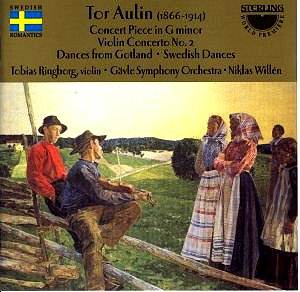Aulin who was to become one
of Sweden’s foremost violinists, came of a
family of violinists. He joined an orchestra
at the age of 14 and studied with Émile
Sauret (dedicatee of the Concert Piece) and
Philipp Scharwenka. He founded the Aulin Quartet
as well as several Swedish musical institutions.
He championed both Berwald and Norman with
various orchestras including the Gothenburg
an orchestra which he co-conducted until 1912.
Sjögren’s E minor violin sonata is dedicated
to Aulin. The Concert Piece (also known as
Violin Concerto No. 1) starts with a gesture
exactly like the propulsive start of the E.J.
Moeran symphony and this returns towards end
of the second movement. The violin writing
is lushly romantic - Bruch and Elgar rather
than Mendelssohn or Delius - a little like
the Sillén concerto recently recorded
by Sterling. The concerto ends with heavily
accented passion. The Second (of three) Concerto’s
themes and treatment do not burn with as dazzling
a flame as the Concert Piece but it is a very
pleasing work with more Bruch, meltingly romantic
string sighs and a dashing Tchaikovskian romance.
In the two sets of Dances (dating a decade
on from the two concertante pieces) Aulin
does an Alfvén or a Bruch (remember
Bruch’s Swedish Dances and other ethnic dance-related
pieces). The Gotland Dances clump and galumph
with stately rustic splendour and with sprightly
yet muscular legs and well-turned heel and
toes. This sequence of three dances is firmly
in the territory we know from Henry Wood’s
Fantasia on Old English Sea Songs with
the odd episode we can relate to Elgar - either
his Bach orchestrations or the Wand of
Youth suites (tr.7). The four Swedish
Dances sparkle and are full of life - cheery,
chilly and ruddy. The flighty first dance
suggests a nineteenth century counterpart
to Malcolm Arnold. The third sounds a little
like the susurration of Rachmaninov’s Isle
of the Dead. While there is the occasional
whiff of fake ‘antiquery’ (cf. Walton’s score
for Henry V - the music for The Globe) this
is mostly sincere unassuming music.
All praise to Bo Hyttner yet again and to Ringborg
and Willén for resurrecting these scores and completing the canon
of Aulin violin concertos. The Third has been recorded before. The disc
is superbly documented in Swedish, English, French and German. Handsomely
done, superbly performed and recorded. Well meriting your attention
if you are a fan of the romantic nineteenth century violin concerto
and of the interaction of classical orchestral music with folk dances.
Rob Barnett

![]() Tobias Ringborg
(violin)
Tobias Ringborg
(violin) ![]() STERLING CDS-1050-2
[73.35]
STERLING CDS-1050-2
[73.35]